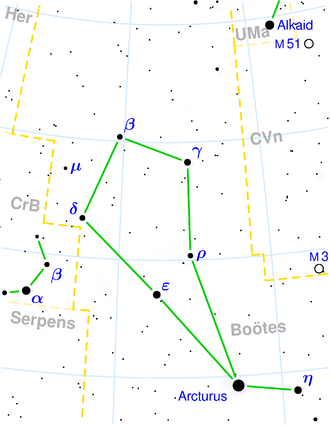NGC 5723
| Galaxie NGC 5723 | |
|---|---|
 | |
| SDSS-Aufnahme | |
| AladinLite | |
| Sternbild | Bärenhüter |
| Position Äquinoktium: J2000.0, Epoche: J2000.0 | |
| Rektaszension | 14h 38m 57,9s[1] |
| Deklination | +46° 41′ 23″[1] |
| Erscheinungsbild | |
| Morphologischer Typ | E-S0[1] |
| Helligkeit (visuell) | 14,0 mag[2] |
| Helligkeit (B-Band) | 15,0 mag[2] |
| Winkelausdehnung | 0,7′ × 0,2′[2] |
| Positionswinkel | 3°[2] |
| Flächenhelligkeit | 12,9 mag/arcmin²[2] |
| Physikalische Daten | |
| Rotverschiebung | 0,036399 ± 0,000170[1] |
| Radialgeschwindigkeit | (10912 ± 51) km/s[1] |
| Hubbledistanz vrad / H0 | (493 ± 35) · 106 Lj (151,1 ± 10,6) Mpc [1] |
| Geschichte | |
| Entdeckung | R. J. Mitchell |
| Entdeckungsdatum | 16. April 1855 |
| Katalogbezeichnungen | |
| NGC 5723 • PGC 52354 • CGCG 248-016 • MCG +08-27-15 • GC 3973 • | |
NGC 5723 ist eine 14,0 mag helle Linsenförmige Galaxie vom Hubble-Typ E-S0 im Sternbild Bärenhüter.
Sie wurde am 16. April 1855 vom irischen Astronomen R. J. Mitchell, einem Assistenten von William Parsons, entdeckt.[3]
Weblinks
- NGC 5723. DSO Browser, abgerufen am 17. April 2016 (englisch).
- NGC 5723. SIMBAD, abgerufen am 17. April 2016 (englisch).
- Auke Slotegraaf: NGC 5723. Deep Sky Observer's Companion, abgerufen am 17. April 2016 (englisch).
Einzelnachweise
Auf dieser Seite verwendete Medien
Autor/Urheber: Sloan Digital Sky Survey, Lizenz: CC BY 4.0
The sky image is obtained by Sloan Digital Sky Survey, DR14 with SciServer.
Angle of view: 4' × 4' (0.3" per pixel), north is up.
Details on the image processing pipeline: https://www.sdss.org/dr14/imaging/jpg-images-on-skyserver/



